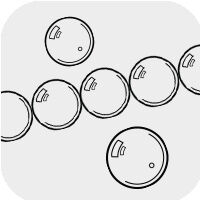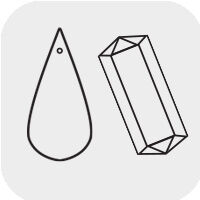Hemalyke™
Meaning and Properties
Hemalyke™ History
This shiny, metallic grey manmade material is exactly what its name says it is: Hemalyke™, a "look alike" for natural hematite--without its cost. Created to replicate the look and feel of natural hematite, Hemalyke is a brand name for this man-made material. Hemalyke and other hematine materials are frequently manufactured as magnetic beads and components. It is easy to produce and easy to cut or mold into a variety of shapes.
Hemalyke™ Metaphysical Properties
Although a manmade stone may not carry all the metaphysical values of its natural equivalent, magnetic Hemalyke has its own sought-after properties in magno-therapy.
Adherents of magno-therapy believe that magnets placed close to the body can have physical effects: promoting bloodflow, relieving pain, increasing joint flexibility and other beneficial soft tissue effects. Other proponents of magnetic therapies use them to rebalance bodily energies to promote holistic health.
Hemalyke™ Geological Properties
Hemalyke contains a range of ingredients, but is mainly composed of ferric oxide, calcium and manganese.
Proper Care of Hemalyke™
This manmade material is extremely durable. Store individually to prevent it from damaging gemstones and other jewelry pieces.
Designing with Hemalyke™
This mirror-like metallic dark grey material is so popular, it's available in half-drilled beads for rings and earrings, a multitude of shapes in bead strands and a variety of beautiful pendants. Use Hemalyke in jewelry when you want a shiny almost gun-metal black or to add a sleek, modern look. With Hemalyke, you get hematite's beauty but with a uniformity and price that's far superior.
This range of options means Hemalyke's dark neutral hue can be used in traditional as well as sleek, modern creations. It blends well with both bright colors and subdued tones, and is popular with designers focusing in both steampunk and cyberpunk designs.
View more resources featuring Hemalyke, including Design Ideas, Videos, Tutorials and more!
Shop for Hemalyke
**Please note that all metaphysical or healing properties listed are collected from various sources. This information is offered as a service and not meant to treat medical conditions. Fire Mountain Gems and Beads® does not guarantee the validity of any of these statements.
How did you like this resource? Your feedback helps us provide resources that matter to you most.
Copyright Permissions
All works of authorship (articles, videos, tutorials and other creative works) are from the Fire Mountain Gems and Beads® Collection, and permission to copy is granted for non-commercial educational purposes only. All other reproduction requires written permission. For more information, please email copyrightpermission@firemtn.com.



